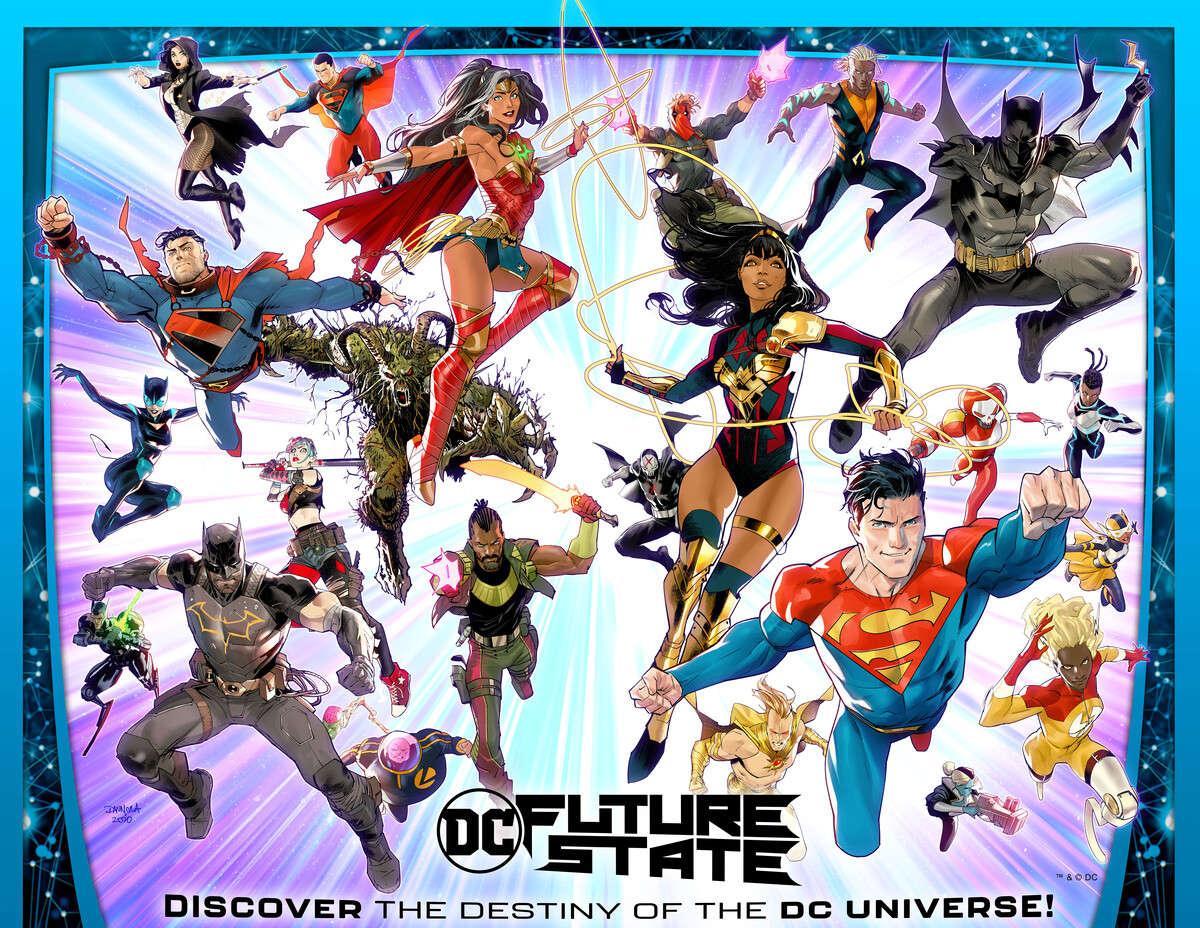Create a free profile to get unlimited access to exclusive videos, sweepstakes, and more!
Comics Wire: DC's Future State and Star Wars' High Republic kick off, plus Eternals & hot reads

Welcome to Comics Wire, SYFY WIRE's weekly comics column that gets at the pulse of what's going on in comics right now. We've got what you need to know about huge crossovers, real-life issues facing the industry, cool first looks, the week's hot new comics, and everything in between.
Well, we've come to a particularly exciting week in the DC Universe. After months of build-up, Dark Nights: Death Metal came to an end this week with its seventh and final issue, and rather than closing the door on its way the epic miniseries from Scott Snyder and Greg Capullo instead kicked every door in sight open to a world of possibilities. This week also brings with it the launch of Future State, DC's massive two-month effort to launch a collection of miniseries from top-tier talent, each of them providing a glimpse into various possible DC Universe futures. New characters are arriving, familiar faces get new roles, and it's all building to something DC is dubbing Infinite Frontier, which will launch in March along with the return of the regular DC titles.
But how did we get here? How exactly did Death Metal set up Future State, and what exactly do the circumstances behind this two-month publishing initiative mean for the future of the DC Universe. Let's talk about that for a moment.
Warning: I'm going to be light on exactly how the events of Death Metal brought this about, and stick to the big picture, but if you're precious about spoilers know that I'm dropping a few from Death Metal #7 below. Feel free to just scroll on down to the next section of the column if you're nervous.
So, after the events of Death Metal proper wrap up, we're treated to an epilogue in which various major players in the saga lay out what the DC Universe looks like now that things have been set right. Our heroes and their timeline have been restored, of course, which means no more Metalverse Earth (I hope Castle Bat comes back, though), but there's much more than that. Because the past of the DC Universe has been restored — including the past beyond the current one established by Rebirth, it would seem — it's explained that "new futures" are opening up around them, and our heroes will see "flashes" of those as "Hypertime heals."
This feels like a pretty quick way of rattling off an explanation for Future State, but I don't want to just skate past the mention of Hypertime there, because Hypertime was once upon a time a major player in DC's way of explaining alternate timelines, continuity goofs and overcorrections, and all manner of other weird shifts back when the Multiverse was around. Essentially, as Chris Sims once explained, Hypertime is "whatever you want it to be," because it allows for an infinite web of alternate timelines to weave in and out of each other and, for example, allow various popular Future State characters to keep appearing in future main DC titles for years to come. Hypertime never went away exactly, but mentioning it here on the eve of Future State feels momentous...or at least, feels like it could be momentous.
But wait, there's more! As if the flexibility of Hypertime wasn't enough, there's also the declaration that the Multiverse is expanding not just by growing new Earths, but by growing new Multiverses into something Snyder's script dubs an "Omniverse," a Multiverse of Multiverses that's perhaps bigger than anything DC has played with before. And at the center of it all, apparently isn't the Prime Earth. There are two mysterious new power sources, including an "Alpha World" that's dubbed "The Elseworld." This last fact is still by far the most mysterious of any of this, and we might have to wait until March or later before all of that becomes clear.
So, what does all of this mean? Well, in the short term it means creating an environment for something like Future State — an event that doesn't dispose of any fan-favorite characters but also creates space for new creations to run — to thrive without ever putting any real limitations on it. It's a two-month event, yes, but telling your readers that Hypertime is healing and that new Multiverses are growing also means you reserve the right to use just about anything from this event as many times as you please further down the road. The sense of scale, of declaring infinite possibilities, buys you that kind of narrative flexibility, but if you ask me this is about more than logistics.
For me, DC Comics has always thrived when it embraces scope, and I'm not just talking about the scope of a multiverse. I'm talking about half a dozen speedster characters or half a dozen Robins or five different Green Lanterns from Earth uniting in one comic. I'm talking about the return of the Justice Society. I'm talking about family and legacy and bonds that stretch across decades that have managed to survive everything from Crisis on Infinite Earths to Invasion to Zero Hour. Death Metal was, at its core, an event about celebrating that interconnectedness, and about growing and progressing without ever sacrificing it.
Now, with the mission statement of this epilogue, DC seems poised to carry that "It all matters" ethos not just into the past, but into the future. I want that, because I want new readers to come to comics and know that they can find something — a Yara Flor or a Jess Chambers or a Jon Kent — that works for them now and know that there's still space for them to learn about the legacy that gave us those characters. We spend too much time trying to pick one over the other, in fandom and in publishing. Right now at least it feels like DC is trying to say we don't have to choose. I hope that's true, because those are the comics I want to read.
The High Republic comics expand Star Wars universe
DC is not alone in launching a brand new massive publishing iniative this week. Disney and Lucasfilm have a major push of their own with Star Wars: The High Republic, a cross-media effort to branch Star Wars storytelling out into an era of a galaxy far, far away's history well before the prequels, at a time when Yoda was a spry 700-year-old Grandmaster and the Jedi really were still the thriving beacon of peace that Qui-Gon Jinn hoped they could still be.
Perhaps the biggest High Republic launch so far is the first novel to come out of the initiative, Charles Soule's Light of the Jedi, but that's far from the only announced project, which brings us to the comics side of the effort. I know this isn't the case for die-hard fans, but among casual Star Wars lovers I feel like comics very often get forgotten, buried beneath the films, the TV series, the video games, and the novels. That's a shame, because ever since Disney began its effort to launch a whole new expanded universe in 2015, Star Wars comics at both Marvel and IDW have been some of the most consistently entertaining Star Wars stories out there. The Darth Vader series in its various incarnations has been a particular bright spot when it comes to adding important continuity and context, the main Star Wars title has enriched the original trilogy in huge ways, and Doctor Aphra and her supporting cast remain some of the best new characters of the Disney era.
That means The High Republic stands a very good chance of adding very worthwhile stuff to Star Wars in comics form as well, and that effort began this week with Marvel's new series titled simply The High Republic. Written by Cavan Scott and drawn by Ario Anindito, it's the story of a young Padawan on the Outer Rim who finds herself swept up in a major galactic moment that just might be hiding more darkness than she realizes. The first issue is fantastic, and it got me excited for all the other comics coming down the High Republic pipeline in the months to come.
We already knew that next month would bring with it IDW's Star Wars: The High Republic Adventures from writer Daniel José Older and artist Harvey Tolibao, but Lucasfilm's High Republic rollout event on Monday also added two more comics projects to look forward to. Scott is also set to launch a graphic novel, The Monster of Temple Peak, alongside artist Rachael Stott, and Viz Media is also set to get into the game with a new series of manga releases. The first of these, The Edge of Balance, will be written by The High Republic: A Test of Courage author Justina Ireland and Shima Shinya with art from Mizuki Sakakibara.
Neither of the new projects have release dates, but consider this your reminder that, if you love Star Wars, you should definitely keep watching the comics side of things in the months to come. The High Repubic has a lot to offer, and it's only just beginning.
More news: Project Patron, The Marvels, and a Power Rangers Kickstarter
- I'm always happen to pay attention anytime Steve Orlando decides to put himself behind the wheel of a new high-concept comic that breaks down superhero tropes as we know them and builds something new. He did that very well with Commanders in Crisis last year, and this year he's set to do it again with Project Patron, a new AfterShock series teaming him with artist Patrick Piazzalunga. The series follows the aftermath of the death of a Superman-like figure known as the Patron, and what happens when a secret project is devised to pretend he's still alive by creating a Reploid body that's piloted by anonymous, behind-the-scenes heroes. The possibilities for thematic excavation and inventive action seem endless there, and I can't wait to find out more. Project Patron launches in April.
- The past few years have seen a resurgence of interest in Kurt Busiek's Marvels that's come in the form of both anniversary celebrations for the original miniseries and new stories told in the same style. Now, Busiek's preparing for what might be his most ambitious Marvels follow-up yet. The Marvels is a new series, featuring art by Yildiray Cinar, that will allow Busiek to explore the length and breadth of the Marvel Universe, from the very first heroes in the past to characters from the future we haven't even met yet. In the press release announcing the release date for the comic, Marvel noted the series will allow Busiek to tell stories ranging from "epic adventure to intense human drama," which makes it sound a bit like Astro City in the Marvel Universe, something I'm very much here for. The Marvels begins in April.
- Late last year, BOOM! Studios steered its Power Rangers comics into an ambitious new era led by two new ongoing series, closing the book on the massive chapter of storytelling that was the original 55-issue Might Morphin Power Rangers comic. Now, the publisher is preparing to commemorate the end of that era with a massive new six-volume premium hardcover set collecting the complete MMPR run, along with never-before-seen extras. BOOM! launched a Kickstarter campaign this week to allow pre-orders for the MMPR Mighty Kickstarter Edition, and the campaign raised more than four times its $50,000 goal in less than 24 hours. If you're a Power Rangers superfan and you want to get in on the action, you can get the whole set for $500 or pick a single volume for $100.
New Comics: Eternals, Future State, Savor, and more!
That's the news. Now let's talk about some of the comics I got excited about this week.
Eternals #1: It's fairly common at this point for comics publishers to get new series launches or fresh trade printings out the door in time for curious readers to have them in conjunction with a new movie, but with Eternals it feels like there's a good deal more riding on the new ongoing series than capitalizing on a feature film. After all, this isn't just a new volume of a beloved team's adventures arriving in time for a movie after years of continuous publication. This is the first Eternals ongoing in years, an attempt to both introduce the team to a new generation of readers and to reinvent their mythos in ways that allows them to survive and thrive in the Marvel Universe as we know it now, something anyone familiar with the history of the characters knows is easier said than done. So, how does Marvel propose to do that?
Well, step one was getting Kieron Gillen to write it and Esad Ribić to draw it, and that seems to be working out very well so far.
Gillen, who's no stranger to synthesizing years of mythology and worldbuilding down into something new at the launch of a project, walks a bit of a tightrope with his approach to this series launch, one that's designed to play to the various strengths of each element he has in his toolbox. There's an intimacy to the focus of this first issue — which largely follows a newly resurrected Ikaris as he heads back out into the world — that's somehow offset by the sheer scale of worldbuilding present in Ribić's always-masterful panels. The plot is tight, yet there are charts and character listings all meant to convey something massive bubbling beneath this first chapter. The subject matter is serious, even mythic in its thematic weight, yet the book is often surprisingly funny. It's an elegant dance between various tonal frequencies that, in the hands of another team, might have become nothing but noise. For Gillen and Ribic it becomes a symphony of possibility.
Eternals #1 does exactly what it sets out to do — introducing the characters and their world to new readers while also honoring what came before — and it does in a tremendously entertaining way. We're well on our way to what could be one of the year's most entertaining new superhero series.
Future State: Swamp Thing #1 and Future State: Wonder Woman #1: I tried to pick just one of the new Future State titles, and in subsequent I probably will only focus on a single book at a time. But the launch of the intiative this week proved a little too momentous for me to narrow things down to a single series, so instead we're going to talk about two, both of which are standout stories that explore the real potential of what something like Future State can achieve.
In Future State: Swamp Thing #1, writer Ram V and artist Mike Perkins imagine a future that has driven humanity to the shadows, where Swamp Thing is not a creature lurking in the trees but a ruler over them, and where the Green has taken root not just as overgrowth in what used to be cities, but as a family Swamp Thing can call his own. Right away there's a depth to this concept, a sense that it's been earned by worldbuilding and emotional framework construction that we didn't actually get to see, but we can feel. Ram V's scripting proves yet again why he's getting higher and higher profile work at DC, as he delivers a story that both carries the mythic weight of Alan Moore's glory days and feels determined to grow into something new, a more ambitious conception of what we can imagine Swamp Thing to be. Then there's Perkins' art, which he absolutely knocks out of the park whether we're talking about beautifully intricate character work or sweeping ruined cityscapes. I know this is a miniseries, but I'd easily read this comic for two years.
And speaking of knocking the art out of the park, there's Future State: Wonder Woman #1 from writer/artist Joelle Jones. Another story of the "next" version of a key hero — this time the new South American Wonder Woman, Yara Flor — Jones wastes no time in trying to justify the presence of a new hero in our midst, and it becomes clear from the opening pages that Yara requires no justification or approval from us. There's a confidence flowing through this issue — through Jones' witty dialogue and clean pencils — that makes you immediately sit up and pay attention in the way that the very best Diana Prince stories do.
There's very little in the way of preamble and even less in the way of trying to justify why it's OK that Yara is here and Diana is not, because Jones isn't telling a Diana story with Yara's personality slapped on top of it. As the key dilemma of the issue unfolds and Yara undertakes a mythic quest, Jones' script transitions into a new kind of DC Comics mythological journey, one that's equal parts funny and inventive, dramatic and wide-eyed. It feels like we're watching a new corner of the universe roll out before our eyes, and that's both exciting and nourishing. I can't wait to see where this goes.
Savor: I've written often about how suited to imaginative flexibility the comics medium is, and Savor is another example of that executed in a tremendously entertaining way. As its name suggests, the graphic novel from writer Neil Kleid and artist John Broglia is a recipe, one that merges many different influences — East and West, cooking and martial arts, comedy and mythology — into one glorious stew of comic book fun perfect for adults and young readers alike.
The book follows Savor Batonnet, a young "warrior-chef" who's just returned to her island home after years of traveling the world to learn everything possible about the people and the food in it. Upon her return, though, she finds the island, famous for its diverse array of restaurants, overrun by demons in search of a legendary blade. To save her home and her family, Savor must marshal all of her culinary and martial gifts, forge the greatest knife the world has ever known, and defeat the villains in spectacular fashion.
What follows this setup is something that feels equal parts Iron Chef and Game of Death, part Avatar: The Last Airbender and part Chopped, as Savor faces an array of challenges that unfold with manic glee through Broglia's joyous pencil work. Every page seems to bring with it a new level of culinary-kung-fu fusion, and the inventiveness and expressiveness just keeps building on page after page. Kleid's script provides that structure, lays in plenty of witty and warm dialogue, and packs more food puns than your stomach or your brain can possibly handle. I had a blast with this book.
The Last Witch #1: As much as I'm addicted to massive, bombastic superhero epics, I also have a lot of room in my heart for the kind of comics that craft an emotional landscape that's just as big, or bigger, as the physical one the story occupies. With the right creators behind it, a tale can engage you with a sense of scope far beyond what the characters or the plot might seem to suggest, and when that happens you end up swept away to somewhere magical.
That's what happened when I read the first issue of The Last Witch, the new fantasy series from writer Conor McCreery and artist V.V. Glass. Functionally speaking, it's the story of a young girl named Saoirse who wants to disobey her father and run out into the woods to find something that might not even be there. Emotionally, though, it's so much more.
That sense of more begins with Glass's art, which deepens every fiber of this story with a style that's both warm and packed with dark fantasy promise as Saoirse heads out into the woods in search of a fabled "witch's tower." It's the kind of book you could get lost in for hours when Glass is doing their best to soothe and evoke a sense of wonder, and then it takes a turn and delivers a wonderfully creepy new plot development just a page later. McCreery's script only serves to enhance this, as he knows exactly when to let the art take over and when to infuse the page with nimble dialogue. The result is a first issue with the power to make you feel like a child again, wandering in the woods or in a park where every tree, every rock, every blade of grass could have magical potential. I'm so excited to see where this story goes next.
Scout's Honor #1: Comics has always been welcoming format for grim future comics, whether we're talking about Judge Dredd or Old Man Logan, because you can deliver sweeping views of a crumbling world with the only limit being the skill of a penciller, but even with that in mind the past couple of years have been a particularly fertile time for post-apocalytpic books. There are so many that it might be easy to get sick of them, if they didn't keep producing such entertaining high concepts. Which brings us to Scout's Honor #1, the launch of a new AfterShock series from writer David Pepose and artist Luca Casalanguida.
This story begins, like a lot of stories in the subgenre do, with a great disaster that forces humanity to go to ground until such time as they can go back out and rebuild among the ruins. Years after the disaster, when humans finally do start to colonize the surface of the United States again, they do so with a governmental and spiritual system completely reorganized around a Ranger Scout handbook. It's into this strange new structure that Pepose and Casalanguida introduce Kit, a gifted Scout who's about to stumble upon to a secret that it will shake everything about this fragile society to its core.
Casalanguida, fresh off the triumph of Lost Soldiers over at Image, absolutely crushes this view of a fallen America, from the mutated creatures that populate its landscape to the design of the Scout-based governmental system itself. It's another artistic showcase, and it's all set up beautifully by Pepose's script, a whip-smart blend of solid, emotionally-driven dialogue and worldbuilding that does something I thoroughly love in this subgenre: Plays up our expectations based on the tropes we've come to recognize and love, and then subverts them expertly. If it's able to sustain this level of quality, Scout's Honor could be one of the most compelling genre series of 2021. It's certainly already one of the most compelling debuts.
And that's it for Comics Wire this week. Until next time, remember what John Custer told his son Jesse in the pages of Preacher:
"You gotta be one of the good guys, son: 'Cause there's way too many of the bad."






























